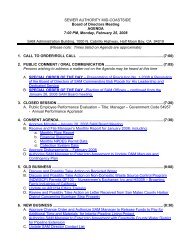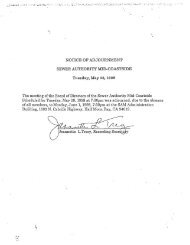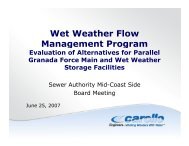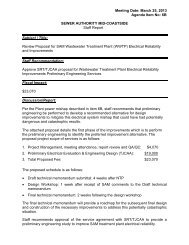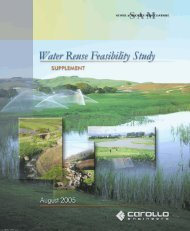PROJECT MEMORANDUM - Sewer Authority Mid-Coastside
PROJECT MEMORANDUM - Sewer Authority Mid-Coastside
PROJECT MEMORANDUM - Sewer Authority Mid-Coastside
You also want an ePaper? Increase the reach of your titles
YUMPU automatically turns print PDFs into web optimized ePapers that Google loves.
<strong>PROJECT</strong> <strong>MEMORANDUM</strong><br />
Project Name: Wet Weather Flow Management Program Date: 06/18/07<br />
Client: <strong>Sewer</strong> <strong>Authority</strong> <strong>Mid</strong>-<strong>Coastside</strong> Project Number: 6851G.00<br />
Prepared By:<br />
Reviewed By:<br />
Subject:<br />
Distribution:<br />
Colin Barrett & Shawn Dent<br />
Michael Britten<br />
Evaluation of Alternatives for Parallel Force Main and Wet Weather Storage Facilities for<br />
Portola Pump Station<br />
John F. Foley III and Tony Pullin (SAM)<br />
BACKGROUND<br />
The <strong>Sewer</strong> <strong>Authority</strong> <strong>Mid</strong>-<strong>Coastside</strong> (SAM) is in its 10th year of implementing the Wet Weather Flow<br />
Management Program. The last phase of the program is to add pumping and wastewater storage<br />
facilities to accommodate peak wet weather flows that are received at the Portola Pump Station and<br />
pumped to the SAM Wastewater Treatment Facility (WWTF).<br />
Wastewater flow rates in the member agency sewers and the Intertie Pipeline System (IPS)<br />
increase significantly during rainy weather. The volume of flow in the sewers depends on the<br />
rainfall intensity and duration for a given storm. In 2005, the SAM board adopted a 10-year, 6-hour<br />
design storm event as the basis for controlling wet weather overflows.<br />
The projected peak wet weather flows for the design storm exceed the current pumping capacity at<br />
the Portola Pump Station. Peak flows also exceed the hydraulic (flow carrying) capacity of the<br />
Granada force main, which conveys the pumped flow from Portola Pump station, and the<br />
downstream gravity section. The force main and gravity section are the limiting restriction in<br />
hydraulic capacity. In previous studies by Carollo Engineers (Carollo), 2 approaches to increase<br />
hydraulic capacity were considered. The first was to provide flow storage facilities (either buried<br />
pipes or an underground storage tank) in the field between the pump station and Highway 1. This<br />
would allow the peak flows to be stored off line and brought back to the pump station after the<br />
storm passes and influent flows subside. Under this approach the pump station would not be<br />
expanded .The second approach was to add a parallel force main, increase pumping capacity, add<br />
a smaller volume of storage at the Portola Pump station, and utilize existing concrete basins at the<br />
wastewater treatment plant for additional storage.<br />
Adding a larger volume of storage at the Portola Pump Station would eliminate the need for an<br />
additional force main, but there are permitting and technical issues associated with the proposed<br />
site. The California Coastal Commission would play a key role in permitting because the storage<br />
site is adjacent to the beach and within the Commission’s jurisdiction. The proposed site is near a<br />
popular beach and therefore the design would need to incorporate features to minimize impacts to<br />
the public. The recommended arrangement, as described in previous studies by Carollo, was to<br />
provide underground storage. In addition to minimizing impacts, the storage facilities would need to<br />
be designed for safe access for maintenance and cleaning. Land would also need to be acquired<br />
for the site.<br />
For the parallel force main option, a new right of way may be needed for the new force main.<br />
Several permits will be required, from agencies such as the California Coastal Commission,<br />
California Department of Fish and Game, Caltrans, and possibly the Corps of Engineers for creek<br />
crossings. In addition, the pipeline will require clearances for the California Environmental Quality<br />
Act (CEQA). Because this would be a major project in sensitive areas, it is likely that an<br />
H:\Final\Sam_WCO\6851G00\PM\062107.doc 1
environmental impact report (EIR) will be required. Potential growth inducing impacts from the<br />
parallel pipeline may need to be evaluated.<br />
In another study by Whitley-Burchett & Associates (2007), a parallel force main was recommended<br />
to increase hydraulic capacity and provide a redundant pipeline. The existing Granada force main<br />
is approximately 27 years old and needs maintenance. Construction of a parallel force main would<br />
increase the capacity of the Portola Pump Station, facilitate maintenance of the existing force main,<br />
and provide redundancy in the case the existing force main failed. However, additional wet weather<br />
flow storage would still be needed at the Portola Pump Station and WWTF. Computer modeling of<br />
this scenario (Alternative 3B), by Carollo in January 2005 showed that approximately 30,000<br />
gallons of storage would be required at Portola Pump Station and 100,000 gallons of storage would<br />
be needed at the WWTF. See Figure 1 for a visual depiction of this scenario.<br />
The purpose of this study is twofold:<br />
1. Evaluate and recommend storage/pumping alternatives, assuming a parallel Granada force<br />
main would be added to accommodate flows from a 10-year, 6-hour design storm.<br />
2. Review the computerized hydraulic model to evaluate parallel force main alternatives.<br />
3. Perform a Technical Confirmation of the Granada Force Main Report by Whitley Burchett &<br />
Associates<br />
ADDITIONAL MODEL ANALYSIS OF THE IPS<br />
Carollo last modeled the effects of a 10-year, 6-hour design storm on the IPS in January 2005. The<br />
modeling was performed assuming a parallel force main would not be added. Two alternatives were<br />
analyzed. Alternative 3A was developed under the assumption that all excess flows would be stored<br />
at Portola Pump Station. The model indicated that a storage volume of 600,000 gallons would be<br />
required. Alternative 3B was developed assuming that a parallel force main would be constructed.<br />
The model resulted in a required storage volume of 30,000 gallons at Portola Pump Station and<br />
100,000 gallons at the WWTF.<br />
For this study, additional hydraulic modeling was preformed with adjustments to the control strategy<br />
to maximize storage in the in the upstream storage tank at Montara Pump Station, and reduce peak<br />
flows to the Portola Pump Station. Assumptions in modeling the system are noted below:<br />
1. The model developed in January 2005 for a 10-year, 6-hour event (Alternative 3B) was<br />
modified to convey excess flow from Portola Pump Station to the WWTF for storage. The<br />
use of storage at Montara would be optimized by applying a control scheme that limits flows<br />
to the Portola pump station, but without exceeding the Montara storage capacity or causing<br />
overflows within the system.<br />
2. The existing Portola Pump Station wet well is modeled as a node with a “working” invert<br />
elevation of 0.0 feet (the elevation of water at the start of a wet weather event). This means<br />
that any increase in depth above 0.0 feet is available storage in the wet well up to an<br />
elevation of about 12 feet. The wet well has a surface area of 324 square feet so that at a<br />
depth of 10 feet in the wet well, it would be storing 3,240 cubic feet, or 24,200 gallons.<br />
3. The Portola pumps will pump as much as possible through two 14-inch diameter force<br />
mains during peak wet weather flows, but the flow level cannot exceed the rim elevation of<br />
the junction box that receives the flow from the Granada Force Main. The junction box is<br />
6.6 feet deep.<br />
H:\FINAL\SAM_WCO\6851G00\PM\062107.DOC 2
sam607f2-6851.ai<br />
Figure 1<br />
ALTERNATIVE 3B<br />
10-YEAR, 6-HOUR EVENT<br />
SEWER AUTHORITY MID-COASTSIDE
4. Flows conveyed to the WWTF exceeding 15 million gallons per day (mgd) (the peak flow<br />
capacity of the WWTF) will be stored at a new WWTF storage basin.<br />
The key results of the hydraulic modeling are described below:<br />
1. The control schemes used to in the model were adjusted slightly to utilize as much Montara<br />
storage as possible and limit the amount of peak flows entering the Portola Pump Station.<br />
The hydrographs at the Montara Pump Station are shown in Figure 2. The excess volume<br />
is sent to storage.<br />
2. The hydrograph at the Portola Pump Station is shown in Figure 3. This graph shows the<br />
influent and effluent from the pump station. The graph demonstrates that there is no need<br />
for off-line storage at the Portola Pump Station under this scenario. An upgraded Portola<br />
Pump Station, combined with dual force mains, has enough capacity to convey flows from a<br />
10-year, 6-hour storm to the WWTF.<br />
3. The hydrographs at the WWTF are shown in Figure 4. The estimated peak hourly flow is<br />
about 17 mgd. Flows exceeding 15 mgd are discharged to storage, resulting in a required<br />
storage volume for the design storm of about 130,000 gallons.<br />
4. The maximum output for the Portola Pump Station is about 7.1 mgd at a total dynamic head<br />
of about 104 feet (45 pounds per square inch [psi]). This pressure is reasonable and well<br />
within the pumping capabilities and pressure rating of the pipelines. The hydraulic profile<br />
for the force mains operating in parallel is shown on Figure 5.<br />
5. The gravity sewer downstream of the distribution box is 2 feet in diameter, with a long, flat<br />
run. According to the model, the gravity sewer will be surcharged (water level at or slightly<br />
above the top of the pipe) and at capacity at the peak flow of 7.1 mgd. The water level in<br />
the discharge manhole (6.63 feet deep) peaks at about 5.25 feet deep. This profile is<br />
shown on Figure 6.<br />
The modeling results lead to the following conclusions:<br />
1. The aggregate hydraulic capacity of the 2 force mains, gravity sewer, and improved pumps<br />
at Portola Pump Station is approximately 7.1 mgd.<br />
2. With minor adjustments to the controls for the Montara Pump Station, the flows conveyed to<br />
the Portola Pump Station can be limited to within the capacity of the pump station, force<br />
mains (assuming two parallel force mains), and the downstream gravity sewer that flows to<br />
the WWTF. This means that if a parallel force main were constructed and the pump station<br />
capacity were increased, storage would not be required at the Portola Pump Station.<br />
However, a storage volume of 130,000 gallons would still be required at the WWTF.<br />
TECHNICAL CONFIRMATION OF WHITLEY BURCHETT & ASSOCIATES REPORT<br />
The updated model results generally agree with the hydraulic analysis presented in the report. The<br />
recommendations in the report are sound and reasonable. The suggestion to use PVC pipe<br />
instead of ductile iron is acceptable and will be incorporated in this study. With regard to the<br />
suggestion to increase capacity of the gravity sewer downstream of the junction box, the hydraulic<br />
model indicates that the existing sewer will be adequate (see preceding discussion of the model<br />
results) as long as surcharging is acceptable to SAM. Therefore additional costs to replace the<br />
sewer or add a parallel sewer were not included.<br />
H:\FINAL\SAM_WCO\6851G00\PM\062107.DOC 4
sam607f3-6851.ai<br />
Figure 2<br />
MONTARA PUMP STATION HYDROGRAPH<br />
SEWER AUTHORITY MID-COASTSIDE
sam607f4-6851.ai<br />
Figure 3<br />
PORTOLA PUMP STATION HYDROGRAPH<br />
SEWER AUTHORITY MID-COASTSIDE
sam607f5-6851.ai<br />
Figure 4<br />
WWTP HYDROGRAPH<br />
SEWER AUTHORITY MID-COASTSIDE
sam607f6-6851.ai<br />
Figure 5<br />
PARALLEL FORCE MAINS<br />
HYDRAULIC PROFILE<br />
SEWER AUTHORITY MID-COASTSIDE
sam607f7-6851.ai<br />
Figure 6<br />
GRAVITY SEWER<br />
HYDRAULIC PROFILE<br />
SEWER AUTHORITY MID-COASTSIDE
PORTOLA PUMP STATION IMPROVEMENTS<br />
Improvements to the Portola Pump Station are recommended to provide sufficient capacity for peak<br />
flow conditions (with 2 force mains in operation), and improve reliability. These improvements are<br />
common to all alternatives for the dual force main approach. The following improvements to the<br />
pump station are recommended.<br />
1. Replace all 4 pumps. The existing pumps are worn and have experienced frequent<br />
interruptions of service because of clogging by rags. The pumps also need to be replaced<br />
to provide the required peak wet weather flow of 7.1 mgd. The recommended new<br />
configuration is to provide a pair of dry weather pumps and a pair of wet weather pumps.<br />
Each pump in the pair will be redundant to the other. The pumps will be designed to pass<br />
solids and rags. To provide reliability in case of flooding, the pumps will be submersible,<br />
mounted in the dry pit. In the alternatives in which the dry pit will be intentionally<br />
submerged, the pumps will be submersible. The pumps will be the same as the dry-pit<br />
arrangement, but submerged. All 4 pumps will be equipped with variable speed drives<br />
(VFDs) to track the varying influent flow. The VFD will be designed to be by-passed in case<br />
of VFD failure. The dry weather pumps will be configured to pump through a single force<br />
main (either force main can be selected). The wet weather pumps will pump through both<br />
force mains. An automatic control valve system will be provided to automatically switch from<br />
1 force main to 2 force mains. An additional flow meter will be installed on the new force<br />
main. A new valve and flow-metering vault will be added to accommodate the new valves<br />
and meters for both force mains. A preliminary plan and sectional view of the proposed new<br />
pump arrangement is shown in Figure 7. A site plan and meter vault are shown in Figures 8<br />
and 9, respectively.<br />
2. Add new pump discharge header for wet weather pumps. The existing pump header is<br />
inadequate for the peak flows. A new header will be provided for the wet weather pumps to<br />
reduce friction losses. The existing discharge header for the dry weather pumps can be<br />
retained, however, the existing flow meter should be replaced because of inaccuracies. A<br />
new flow meter for the dry weather pump discharge header will be installed in the new valve<br />
and metering vault, where hydraulic conditions will provide more accurate metering.<br />
WEATHER FLOW MANAGEMENT ALTERNATIVES<br />
Four alternatives for the parallel force main option were evaluated. As described previously, each<br />
alternative includes improvements to the pumps for the Portola Pump Station. Please refer to<br />
Figure 10 for schematic drawings for each alternative.<br />
Alternative 1: Modify the Portola Pump Station by converting the dry pit (where the pumps are<br />
currently located) to a wet pit.<br />
This would involve flooding the dry portion of the pump station. Submersible pumps would be<br />
installed in the new wet well. The flooded wet well would provide 80,000 gallons of storage. An<br />
additional 50,000 gallons of storage would be constructed at the WWTF. Storage would be added<br />
to the WWTF by utilizing the tank for Aeration Basin 4.<br />
Storage would be added at the WWTF by converting the existing concrete tank intended for future<br />
use as Aeration Basin 4. Aeration Basin No. 4 is “bare” with no aeration equipment. The aeration<br />
basin was intended for future capacity, but it may never be required, based on current growth<br />
rates. For comparison, SAM is currently operating with one aeration basin without of three available<br />
basins. An overflow box will be added on the 21-inch diameter main sewer next to Aeration Basin<br />
No. 4 (see Figure 11 for a plan and section view of the overflow box location).<br />
H:\FINAL\SAM_WCO\6851G00\PM\062107.DOC 10
ALTERNATIVE 1<br />
Parallel<br />
Force Mains<br />
Gravity <strong>Sewer</strong><br />
ALTERNATIVE 3<br />
Parallel<br />
Force Mains<br />
Gravity <strong>Sewer</strong><br />
Flow from<br />
Montara and<br />
El Granada<br />
Portola Pump<br />
Station<br />
(convert to<br />
submersible<br />
pump station)<br />
80,000 gal<br />
(submersible<br />
pumps)<br />
Junction<br />
Box 2<br />
Treatment<br />
Plant<br />
50,000 gal<br />
Flow from<br />
Montara and<br />
El Granada<br />
130,000 gal<br />
(in field)<br />
Portola Pump<br />
Station<br />
(replace dry<br />
and wet<br />
weather<br />
pumps)<br />
Junction<br />
Box 2<br />
Treatment<br />
Plant<br />
ALTERNATIVE 2<br />
Parallel<br />
Force Mains<br />
Gravity <strong>Sewer</strong><br />
ALTERNATIVE 4<br />
Parallel<br />
Force Mains<br />
Gravity <strong>Sewer</strong><br />
Flow from<br />
Montara and<br />
El Granada<br />
50,000 gal<br />
(in field)<br />
Portola Pump<br />
Station<br />
(convert to<br />
submersible<br />
pump station)<br />
80,000 gal<br />
Junction<br />
Box 2<br />
Treatment<br />
Plant<br />
Flow from<br />
Montara and<br />
El Granada<br />
Portola<br />
Pump Station<br />
(replace dry<br />
and wet<br />
weather<br />
pumps)<br />
Junction<br />
Box 2<br />
Treatment<br />
Plant<br />
130,000 gal<br />
Figure 10<br />
ALTERNATIVE COMPARISONS<br />
SEWER AUTHORITY MID-COASTSIDE<br />
sam607f1-6851.ai
The overflow box will be equipped with submersible pumps, which lift the overflow to Aeration Basin<br />
No. 4. An existing sump pump located in Basin 4 would be used to drain the tank to the head of the<br />
WWTF for treatment. The storage volume of the converted basin, when filled to its highest level, is<br />
approximately 324,000 gallons.<br />
The converted pump station would have two dry weather pumps and two wet weather pumps.<br />
Figures 12 through 14, enclosed, show the proposed pump installation. One of each set of pumps<br />
would serve as a standby pump. A concrete dividing wall would be constructed between the two<br />
sets of pumps to allow separate operation and to reduce the wet well volume during dry weather.<br />
Excessive wet well volume can cause odors. Existing pumps and equipment in the pump and motor<br />
rooms would be removed. A polyurethane coating would be applied to the interior walls to prevent<br />
corrosion and leakage. New equipment hatches would be installed in the existing concrete floor<br />
slabs to allow removal of the submersible pumps for maintenance. A new monorail and hoist system<br />
would also be installed to retrieve the pumps.<br />
It is also possible to convey the overflow to Aeration Basin No. 4 by gravity flow (eliminating the<br />
need for pumps). However, without pumping, the highest level in the storage tank will be limited to<br />
the equivalent of a storage volume of approximately 120,000 gallons.<br />
Alternative 2: Convert Portola Pump Station (with flooded dry pit and submersible pumps as<br />
described for Alternative 2), and add 50,000 gallons of storage volume in the field west of the pump<br />
station.<br />
The storage facilities would consist of a buried, large diameter pipe(s) or an underground, concrete<br />
storage tank. The general arrangement for the storage facility would be 2 buried, parallel pipelines<br />
200 feet in length, for a total length of 400 feet.<br />
Alternative 3: Add 130,000 gallons of underground storage in the field to the West of the Portola<br />
Pump Station. Storage would not be required at the WWTF.<br />
The general arrangement for this alternative would be two buried, parallel pipelines 500 feet in<br />
length, for a total length of 1,000 feet. Figures 15 and 16 show plan and section views of this<br />
alternative.<br />
Alternative 4: Replace two dry-pit pumps at Portola Pump station with new dry pit pumps dedicated<br />
for peak wet weather flow. Add 130,000 gallons of storage at the WWTF. Storage would not be<br />
required at the Portola Pump Station for this alternative.<br />
H:\FINAL\SAM_WCO\6851G00\PM\062107.DOC 16
sam607f10-6851.ai<br />
Figure 12<br />
PORTOLA PUMP STATION<br />
PUMP ROOM MODIFICATIONS<br />
FOR SUBMERSIBLE PUMPS<br />
SEWER AUTHORITY MID-COASTSIDE
sam607f11-6851.ai<br />
Figure 13<br />
PORTOLA PUMP STATION<br />
PUMP ROOM MODIFICATIONS<br />
FOR SUBMERSIBLE PUMPS<br />
SEWER AUTHORITY MID-COASTSIDE
sam607f12-6851.ai<br />
Figure 14<br />
PORTOLA PUMP STATION<br />
PUMP ROOM MODIFICATIONS<br />
FOR SUBMERSIBLE PUMPS<br />
SEWER AUTHORITY MID-COASTSIDE
Avenue Alhambra<br />
Portola<br />
Pump Station<br />
Obispo Road<br />
60" Reinforced Concrete Pipe<br />
(RCP) Storage Pipe<br />
Granada<br />
Sanitary District<br />
Existing 15"<br />
Montara Interceptor<br />
Junction Box<br />
Granada<br />
Sanitary District<br />
Not to Scale<br />
Figure 15<br />
ALTERNATIVE 3 - PLAN VIEW<br />
SEWER AUTHORITY MID-COASTSIDE<br />
sam607f8-6851.ai
60" Reinforced<br />
Concrete Pipe<br />
Trench<br />
Not to Scale<br />
Figure 16<br />
ALTERNATIVE 3 - SECTION VIEW<br />
SEWER AUTHORITY MID-COASTSIDE<br />
sam607f9-6851.ai
COMPARISON OF ALTERNATIVES<br />
Cost Estimate<br />
Planning-level capital costs for the 4 storage alternatives are summarized in Table 1.<br />
Table 1 - Preliminary Cost Comparison of Wet Weather Flow Storage Alternatives<br />
<strong>Sewer</strong> <strong>Authority</strong> <strong>Mid</strong>-<strong>Coastside</strong> (1)<br />
Alternative<br />
Project Element 1 2 3 4<br />
Parallel Granada Force Main and Valve Vault $1,959,000 $1,959,000 $1,959,000 $1,959,000<br />
Storage at WWTF $231,000 $231,000<br />
Convert Portola PS to Submersible PS $1,282,000 $1,282,000<br />
Large Diameter Storage Pipes $340,000 $629,000<br />
New Dry-Pit Pumps at Portola PS $1,237,000 $1,237,000<br />
Total Direct Cost $3,472,000 $3,581,000 $3,825,000 $3,427,000<br />
Estimating Contingency @ 20% $694,400 $716,200 $765,000 $685,400<br />
Subtotal $4,167,000 $4,298,000 $4,590,000 $4,113,000<br />
General Conditions @ 10% $416,700 $429,800 $459,000 $411,300<br />
Subtotal $4,584,000 $4,728,000 $5,049,000 $4,525,000<br />
General Contractor OH&P @ 10% $458,400 $472,800 $504,900 $452,500<br />
Subtotal $5,043,000 $5,201,000 $5,554,000 $4,978,000<br />
Sales Tax @ 8.5% $214,328 $221,043 $236,045 $211,565<br />
Subtotal $5,258,000 $5,423,000 $5,791,000 $5,190,000<br />
Escalation to <strong>Mid</strong>-Point @ 8% $420,640 $433,840 $463,280 $415,200<br />
Total Estimated Construction Cost $5,679,000 $5,857,000 $6,255,000 $5,606,000<br />
Engineering, Legal, & Admin Fees @ 18% $1,022,220 $1,054,260 $1,125,900 $1,009,080<br />
Owner's Reserve for Change Orders @ 2% $113,580 $117,140 $125,100 $112,120<br />
Easement Acquisition $0 $200,000 $200,000 $0<br />
Baker Tank Rentals (Present Value -<br />
6% over 20 years) $0 $0 $0 $0<br />
Total Estimated Construction Cost $6,815,000 $7,229,000 $7,706,000 $6,728,000<br />
Notes:<br />
(1) Planning Level Costs. Engineering News Record (ENR) Construction Cost Index for San Francisco =<br />
9063 June 2007).<br />
(2) Estimated - to be verified with a property value appraisal.<br />
H:\FINAL\SAM_WCO\6851G00\PM\062107.DOC 22
Comparison of Alternatives<br />
A discussion of the advantages and benefits of each alternative is included below.<br />
Alternative 1: This alternative consists of converting the Portola Pump Station dry pit to flooded wet<br />
well, adding submersible pumps at this location, and constructing temporary storage at the WWTF.<br />
Advantages of this alternative are that the Portola Pump Station footprint is not increased and the<br />
submersible pumps are relatively inexpensive when compared to dry-pit submersible type pumps.<br />
Another advantage of this alternative is that storage is provided at two places; this provides SAM<br />
with more operational flexibility during a storm event. Disadvantages to this alternative include the<br />
need for substantial structural modifications and more maintenance of the pumps because the<br />
pumps are submerged. Alternative 1 is the second least expensive alternative.<br />
Alternative 2: Alternative 2 consists of adding storage volume with large diameter pipes in the field<br />
to the west of the pump station, and storage in the converted Portola Pump Station wet well.<br />
Advantages and disadvantages relating to the converted wet well are similar to Alternative 1. In<br />
addition, this option eliminates the need for storage at the WWTF. However, construction would<br />
have to occur in a highly sensitive area immediately west of the pump station. Permitting issues and<br />
high groundwater in this area are significant challenges in implementing this Alternative.<br />
Alternative 3: Under this alternative the entire volume of excess wastewater is contained in large<br />
diameter pipe storage in the field west of Portola Pump Station. The disadvantages of storage in<br />
this plot of land are the same as Alternative 2. In addition, this alternative is the most expensive<br />
option. Alternative 3 is more desirable than Alternatives 1 and 2 from a pump station maintenance<br />
perspective, because the pumps will remain installed in an accessible dry-pit. However, this<br />
advantage may be cancelled out by increased maintenance required to care for the large diameter<br />
storage pipes.<br />
Alternative 4: The final alternative is composed of replacing the dry-pit pumps at the Portola Pump<br />
Station and constructing storage at the WWTF. This alternative is the least expensive of the 4<br />
alternatives. The alternative is preferable from a maintenance perspective because all of the<br />
storage is contained at the WWTF (where the operations staff is based) and the Portola Pump<br />
Station pumps remain in the accessible, dry-pit configuration. A disadvantage to this alternative is<br />
that no storage is constructed at Portola Pump Station; therefore, any excess wastewater<br />
originating in a storm event that exceeds a 10-year, 6-hour storm hydrograph would cause system<br />
overflows at or upstream of the pump station.<br />
Conclusions and Recommendations<br />
• The updated hydraulic model indicates that the combined hydraulic capacity of two 14-inch<br />
force mains operating in parallel and the downstream gravity sewer is approximately 7.1<br />
mgd. At this flow, a portion of the gravity sewer would be surcharged, but the flow would be<br />
contained within the manhole rims. Thus, for the design storm of 10-year intensity with a 6-<br />
hour duration, the design flow for the Portola Pump Station would be 7.1 mgd.<br />
• Alternative 4 is the preferred alternative for the parallel force main approach because it<br />
represents the lowest cost and it will provide improved reliability for the pump station and<br />
the force main.<br />
The recommended project for the dual force main approach consists of the following key elements:<br />
1. Replace the existing pumps in the Portola Pump Station to provide full redundancy and<br />
peak pumping capacity of 7.1 mgd. Upgrades to the pump station will also include new<br />
electrical equipment and expanded standby power.<br />
2. Construct a new, 14-inch parallel force main.<br />
H:\FINAL\SAM_WCO\6851G00\PM\062107.DOC 23
3. Raise the walls of the distribution box just upstream of the gravity sewer to contain higher<br />
levels during peak flow conditions.<br />
4. Add an overflow structure and submersible pumps at the WWTF to divert excess flow to<br />
Aeration Basin 4. Convert Aeration Basin 4 to a wet weather storage tank.<br />
H:\FINAL\SAM_WCO\6851G00\PM\062107.DOC 24



